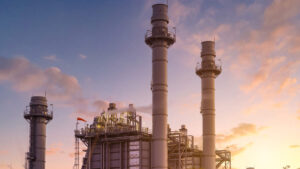POWER UP: The name of the game? Energy security

Pic: Vertigo3d / E+ via Getty Images
Oil prices continued to demonstrate extreme volatility over the past fortnight with the Brent crude benchmark falling very briefly from below US$100/bbl before surging back up this week on inventory concerns and Russia saying that payments for its gas exports had to be made in roubles.
This has led local defence analysts to call for Australia to end its reliance on imported oil with the ABC quoting retired air vice marshal John Blackburn saying the national economy would “grind to a halt” within weeks of a disruption to fuel supplies.
He said the Russian invasion of Ukraine highlighted how Europe’s dependence on Russia oil and gas allowed it to strongarm potential opponents on the sub-continent and that our almost total reliance on foreign oil was just as big a weakness if not bigger.
Australia ostensibly has a strategic reserve but it is held on our behalf in the US Strategic Petroleum Reserve, meaning that said quantities of oil are not even located within our own shores.
This means that should a conflict threaten our shores, our ability to access the reserve – which totals just 1.7 million barrels, or less than two days supply at our 2019 consumption rate of 1.04 million barrels per day – would be uncertain at best.
Energy security paramount
Australian Strategic Policy Institute director of defence, strategy and national security Michael Shoebridge said Australia should bolster its position by processing more domestic oil and gas, though he noted there was a pressing need to fast-track the adoption of green transportation in the longer-term.
While critical, this transition is likely to take some time as despite growing demand for electric vehicles, their sales still represent a fraction of the overall car market.
Lacklustre government programs to drive EV adoption have certainly not helped.
The energy security crisis has also led to calls for Australia to develop green hydrogen to both decarbonise its economy and improve fuel security.
However, transiting away from fossil fuels will require greater (or even complete) use of renewable energy and energy storage and is a task that will likely take decades to complete. There are simply no shortcuts.
Even if we pushed for greater EV adoption by offering big incentives, the fact is that car manufacturers only have a finite ability to produce vehicles and there are long wait lists for popular vehicles.
Hydrogen is still in its very early stages with extremely limited infrastructure and even more limited choices where vehicles are concerned.
The few hydrogen fuel cell cars are thus far only used as government fleet vehicles while home grown designs are still a couple of months away (and have limited production).
Indeed, most pundits believe that the future of hydrogen transport lies in commercial vehicles or long-haul transportation.
Fossil fuels still needed
This means that in the short to medium term, Australia will still have to ensure its fossil fuel supplies in order to maintain energy security.
Coal and gas are both resources that Australia has no shortage of.
While much of our gas is locked up in long-term export contracts – to the point that domestic supplies in the East Coast are looking a little patchy – a conflict could see our gas staying home.
Oil is a little trickier. Not only are Australian oil fields experiencing production declines, our ability to refine crude oil into petroleum products such as diesel and petrol is also limited with just two small and ageing refineries still operating following the closures of the BP refinery in Kwinana, Western Australia and ExxonMobil’s refinery in Altona, Victoria.
The chance that new refineries will be built is pretty much a zero given the long lead time required, high capital cost and the likelihood that it will have a shorter service life.
What is more likely is government support to keep the existing refineries operating, which will grant some measure of energy security.
On the upstream front, the recent discovery of oil at the Pavo-1 well by Santos (ASX:STO) and Carnarvon Energy (ASX:CVN) is potentially very exciting in supporting Australia’s energy security.
While the planned Phase 1 development of the nearby Dorado oil field would only produce up to 100,000bpd from 2026, it would still go a long way towards addressing the decline in Australian oil production.
Pavo-1 itself is likely to be tied back to Dorado, providing the bigger field with additional reserves that would likely extend its production life.
However, its real value comes from highlighting the potential of other prospects within the Bedout Sub-basin offshore Western Australia to host oil as well.
Should these targets also prove commercial, the Bedout could well be one way that Australia maintains its energy security until the day when the baton is passed on to renewables and energy storage.
Related Topics

UNLOCK INSIGHTS
Discover the untold stories of emerging ASX stocks.
Daily news and expert analysis, it's free to subscribe.
By proceeding, you confirm you understand that we handle personal information in accordance with our Privacy Policy.








